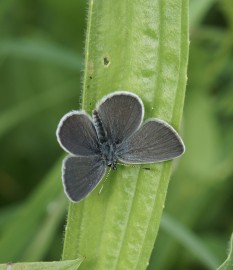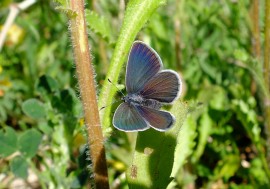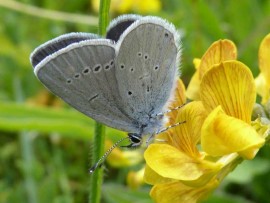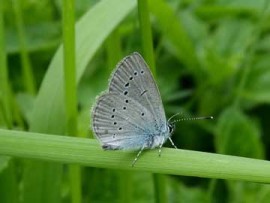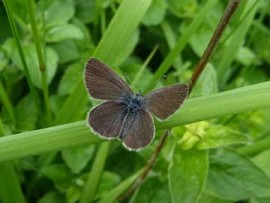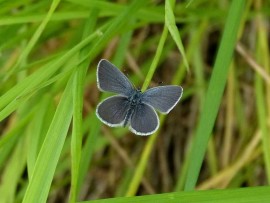by Martin Kalaher
This lovely little butterfly is the smallest of our British butterfly species and within these county borders may be found all along the South Downs. The 2010-14 distribution map shows that it is widely distributed on the chalk between Storrington and Eastbourne with rather fewer colonies in the more wooded part of the South Downs to the west of the Arun Valley.
This species tends to live in very small self-contained colonies, often with just a few individuals present on any given day. Its sole larval food plant is Kidney Vetch, which is an interesting plant species as it only seems to thrive where the soil is extremely thin and where the soil has been recently disturbed. It does not seem able to compete very well with other plant species, including grass, and whilst it may flourish for 3-4 years following a soil disturbance, it is not unusual for it to suddenly and somewhat inexplicably, disappear. Bearing this in mind it should come as no surprise that both plant and insect tend to be associated with embankments or slopes where the soil is very thin and intrinsically unstable. With this understanding of the dynamic between butterfly and food plant it is no wonder that these colonies tend to be small. Look for the distinctive flower heads of Kidney Vetch on sunny, sheltered lower slopes. Once this plant species is found it is very worthwhile having a careful look for Small Blues for very small colonies can be sustained on as little as a couple of dozen plants.
With a little practice this is a butterfly species that can be readily identified whilst in flight. There is the potential for confusion with Brown Argus with which it shares these warm downland slopes, but in sunny conditions the latter "flashes" silver when flying and this distinguishing feature should, on most occasions, differentiate between the two species. The truth is that if a Small Blue is inadvertently disturbed it rarely travels very far, and provided the flight path is followed it will soon land and allow a close scrutiny, for it is not a skittish butterfly. The upper wings of both sexes are a uniform charcoal-grey, but it can be sexed readily enough as the male has a scattering of blue at the wing bases whilst on the upper surface of the female there is no blue at all. When roosting the closed wings can be closely examined, revealing silvery-grey undersides with a scattering of delicate black spots. They are superficially similar to the much larger Holly Blue, but this latter species roosts deep within shrubbery and not out in the open just a few inches off the ground. These differences mean that "in the field" there should be little risk of confusion between the two species.
The males perch prominently in sunny, sheltered nooks waiting for the virgin females to come to them. Courtship is brief and once mated the female avoids these perching areas, concentrating on the patches of Kidney Vetch within the colony, where she feeds, rests, basks and lays her pale-blue eggs between the yellow florets of the flower head. The eggs hatch after 1-3 weeks and the caterpillar burrows deep inside the floret to feed on the developing anthers and seed. Should two or more caterpillars enter the same floret only one will survive, for at this stage in their development the caterpillars are cannibalistic. As they grow older the grey-pink caterpillars live openly on the flower clusters, head down as they bite into the base of the flowers to feed on the developing seed. These older caterpillars are tolerant of their near-neighbours and it is not unusual for there to be more than one caterpillar for each flower head. The first-brood larvae undergo three moults before reaching maturity, when the majority seek security deep within the vegetation where they remain all winter, forming a chrysalis the following April. Others pupate immediately, emerging a couple of weeks later to form the numerically-weaker second brood. In Sussex there appears to be good evidence for a small third brood, when a few adults emerge in mid to late September. All three broods potentially overlap, and the average flight season between 2010 and 2014 was 8 May to 6 September.
Although this species is never likely to be very numerous in Sussex it does seem to be a natural survivor, apparently having the ability to find new areas where Kidney Vetch suddenly becomes available. On occasion this can give rise to a short-lived "population explosion", as occurred at Stanmer Heights (Brighton and Hove) in 2011, when a number of chalk terraces were newly constructed. There were astonishing numbers with daily counts exceeding 1,000 individuals only for this to reduce to a maximum daily count of 140 in 2012 and just 25 by 2014. Another example of this species ability to survive (and indeed thrive) occurred in 2007 when a series of chalk-based butterfly havens were constructed at Dorothy Stringer School in Brighton (the inspiration and design of these butterfly havens by Dr Dan Danahar, the school's biodiversity co-ordinator). Two egg-laying Small Blues were discovered in 2009 and from small beginnings the colony grew and then predictably declined as much of the Kidney Vetch was superseded by other plant species. The interesting point was not that a new colony became established but that the nearest known colony was 3 km distant and as is noted in "The Butterflies of Sussex", "to access this site it must have negotiated the hostile tarmac, concrete and brick of the cityscape". This is no mean feat for such a tiny butterfly which isn't noted for its powerful flying habits!
Sussex BC is indebted to David Harris (current species champion) for his contribution to our collective knowledge as regards this occasional third brood and the Small Blue's association with ants. For further reading please refer to "The Butterflies of Sussex".
The best sites to see this beautiful little butterfly are: Springhead (Kithurst) Hill TQ070125, Castle Hill NNR TQ369071 to TQ366069, Well Bottom TQ4505, Windover Hill TQ532032 to TQ543033, Friston Forest Gallops TV544991 to TV554997.



